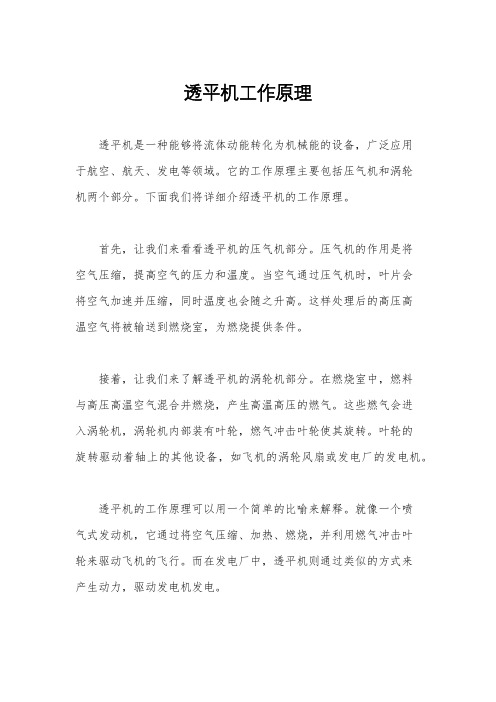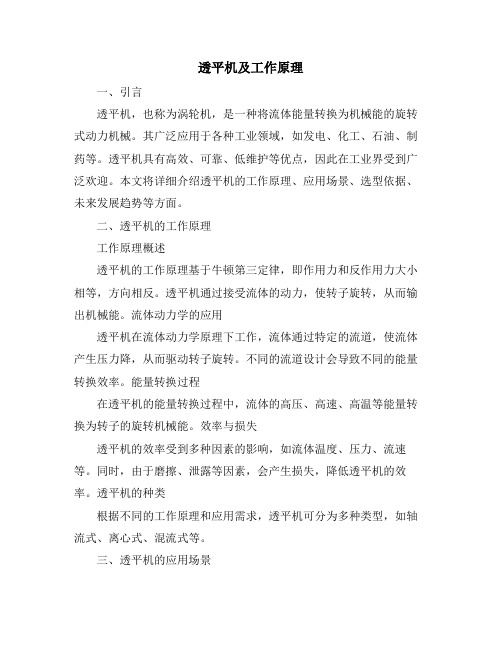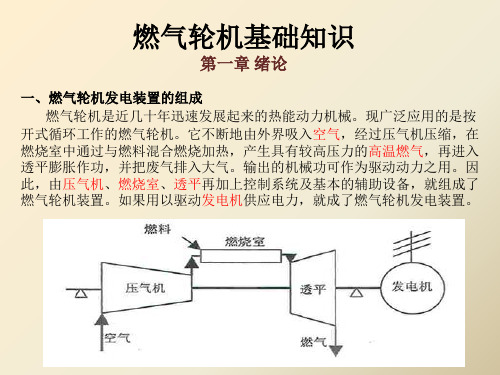燃气轮机(透平)基础知识和基本原理
燃气轮机介绍

西门子 燃气轮机
,
GE 燃气轮机
,
三菱燃气轮机
,
2、燃气轮机结构组成
❖ 2.1轴流式压气机
❖ 压气机负责从周围大气中吸入空气,增压 后供给燃烧室,分轴流式压气机与离心式压 气机(应用较少),这里介绍轴流式压气机。
❖ 轴流式压气机的叶轮由叶片与叶盘组成, 工作原理如同电风扇的叶片,叶片旋转时拨 动空气,流动产生风;压气机的叶轮旋转把空 气推进气缸压缩。
❖ 理论上进入燃烧室的空气压力越高越好,实际上综合各 种因素,,压比较多为 12 至 20。燃气轮机的压气机由本身 的涡轮机带动,燃气轮机启动时,先使用外动力带动压气 机旋转,把空气压入燃烧室。燃气轮机点火后进入运转状 态,则转变至由涡轮带动压气机旋转压气。
西门子 燃气轮机
西门子 燃气轮机
西门子 燃气轮机
1、燃气轮机基本原理
❖ 电站燃气轮机循环主要性能指标:
压比:压气机出口的气体压力P2*与进口的气体压力P1* 之比值,反映工质被压缩的程度。 温比:循环最高温度t3*(燃气初温:第一级喷嘴后缘 平面处的燃气的平均滞止温度)与最低温度t1*之比值。 比功:是指相应于进入燃气轮机的每lkg空气,在燃气 轮机中完成一个循环后所能对外输出的功。 单机功,率:燃气轮发电机组的输出电功率PGTG,为主要的 性能指标。 热效率:当工质完成一循环时,把外界加给工质的热量 转化成为机械功或电功的百分数。
❖ 燃气轮机定义:燃气轮机是将燃料(石油、天然 气)的能量转化为某种形式的有用功,例如机械 功或者高速喷气式动力装置的推力。
❖ 最简单的燃气轮机包括三部分:压气机、燃烧室、 涡轮。
❖压气机——压缩空气(消耗功) ❖燃, 烧室——燃料与空气燃烧(化学能转化为热能) ❖涡 轮——燃气膨胀做功,一部分功用来带动压
透平机及工作原理

透平机及工作原理-标准化文件发布号:(9556-EUATWK-MWUB-WUNN-INNUL-DDQTY-KII透平机及工作原理透平是将流体工质中蕴有的能量转换成机械功的机器,又称涡轮或涡轮机。
透平是英文turbine的音译,源于拉丁文turbo一词,意为旋转物体。
透平的工作条件和所用工质不同,所以它的结构型式多种多样,但基本工作原理相似。
透平的最主要的部件是一个旋转元件,即转子,或称叶轮,它安装在透平轴上,具有沿圆周均匀排列的叶片。
流体所具有的能量在流动中,经过喷管时转换成动能,流过叶轮时流体冲击叶片,推动叶轮转动,从而驱动透平轴旋转。
透平轴直接或经传动机构带动其他机械,输出机械功。
透平机械的工质可以是气体,如蒸汽、燃气、空气和其他气体或混合气体,也可以是液体,如水、油或其他液体。
以水为工质的透平称为水轮机;以蒸汽为工质的透平称为汽轮机;以燃气为工质的透平称为燃气透平。
水轮机--水从高水位水库沿通道流向处于低水位的水轮机的过程中,高水位水的势能变成动能,推动水轮机旋转。
流过水轮机的尾水沿水道流去。
现代水轮机的唯一用途是作为水电站的动力源,带动发电机发电。
汽轮机--它的工质是蒸汽,具有热能。
蒸汽来自燃用矿物燃料的锅炉,或是来自核动力装置加热的蒸汽发生器。
它们产生的高温高压蒸汽以高速度经喷管送到蒸汽透平,驱动转子旋转,输出动力。
蒸汽流速很高,透平转子尺寸较小,所以转速可达10000转/分。
汽轮机主要用于火力发电厂,驱动发电机发电;也用于远洋大型船舶和潜水艇作为主机驱动螺旋桨,推进船舶。
燃气透平--它与压气机、燃烧室成为燃气轮机装置的三大主要部件。
空气供入压气机,压缩成较高压力和温度的压缩空气,流入燃烧室与燃料混合、燃烧,形成高温、高压、高速的燃气流,流入燃气透平并推动燃气透平旋转,经透平轴输出机械功。
燃气透平转速高达每分钟数万转。
现代燃气透平应用最广泛的是作为喷气式飞机的推进动力,有的用作舰船动力、发电厂、尖峰负荷用小型电站,也作为远距离输送天然气的气泵的动力。
燃气轮机教学课件12-透平1

一、二级间轮盘 二、三级间轮盘
一级轮盘 二级轮盘 三级轮盘
转子采用外围拉杆结构,共12根拉杆螺栓。
透平冷却
采用从压气机中抽气来冷却的方法。
分为两部分:
转子和静子的冷却 叶片冷却
根据冷却部位所需压力的高低,
冷却空气自压气机的不同级处引来。 冷却空气量: 约占压气机进口空气流量的10%以上。
静叶栅(0-1)
减 静
压 止
增 喷
管 速
气体与外界无功的交换
0
1 0
dp
1 2
(c02
c12 )
Lr1
c1>c0 p0>p1
1
2
(c12
c02
)
1 dpБайду номын сангаас
0 - Lr1
1 2
(c12
c22 )
(c2c0)
绝对动能 压能
冲动力做功
c12
c02 2
i0
i1
动叶栅
减压增速 转动喷管
且气流方向改变、转折 较大,2>>1 ;
那么气流以绝对速度c2 流出动叶栅,与叶栅额 线的夹角为2。
c2 w22 u22 2w2u2 cos 2
一般1=14~20°
u 动叶
c2 w2 u
sin 2
w2
sin c2
2
基元级的速度三角形
进出口速度三角形画在一起。 注意:
①一般轴向分速度不相等,c2z c1z ;
亚声速气流
画法:
(1)静叶在前,动叶在后
1
标注三个特征截面
(2) 叶片间通道截面渐缩
(3)叶片运动方向
2
叶腹→叶背
燃气轮机第四章 燃气透平 PPT课件

一、先进的透平材料和涂层
图4-26透平叶片材料发展趋势
图4-27先进涂层及其降温效应
二、叶片的冷却技术
两类冷却方式: 叶根冷却
一类把冷却空气吹向叶片外表进行冷却; 叶片冷却 一类把冷却空气通入叶片内部的专门流道进行冷却。
非常复杂:
叶片整个浸浴在高温燃气中,无法实现外部冷却; 叶片本身尺寸小,形状也较复杂,内部冷却复杂。
采用空气冷却叶片——从压气机引来一定量的空气,使 其流过叶片内部的冷却通道后,排入主燃气流中。
措施:在冷却空气入口处加装滤网;自压气机内径处引来冷 却空气;在动叶顶开清除孔 。
三、透平叶片的闭环蒸汽冷却
从外部引来蒸汽,对透平的静叶和动叶片冷却后再 引至外部,即蒸汽与燃气隔开而不流入燃气中.
优点:
①消除了冷却空气掺入导致的燃气温度降低; ②无冷却空气掺混引起的扰动,消除扰动损失; ③不需要从压气机中引气,减少了抽气损失。
i > 12~15°
用特性曲线定量估算这种影响。
二、透平特性线的表示方法
通常采用相似参数来绘制
以相似参数为坐标绘制的特性线为通用特性, 不受具体参数变化的影响。
qT T3* p3*
n T3*
T
p3* p4*
T
PT T3*
流量相似参数 转速相似参数
Macz
MauBiblioteka 流动相似=几何相似+运动相似+动力相似
燃气轮机基础知识.

燃气轮机转子
燃烧室产生的高温膨胀气体是同时作用到涡轮叶片与压气机叶片 上,如何保证涡轮带动压气机正向旋转呢,简单说涡轮叶片工作直径 大于压气机出口处的叶片工作直径,涡轮叶片的面积也大于压气机出 口处的叶片面积,这就初步保证在同一压力下涡轮的输出力矩大于压 气机所需的力矩,当然更重要的是压气机叶片与涡轮叶片的良好空气 动力学设计才能保证两者高效运行。燃气轮机在设计时就要保证涡轮 机输出的功率要大于压气机所需的功率,才能使燃气轮机在带动压气 机的同时还能向外输出功率。
轴流式压气机
压气机负责从周围大气中吸入空气,增压后供给燃烧室,从工作原 理上讲,主要有轴流式压气机与离心式压气机。离心式压气机工作原 理与离心式鼓风机(或离心式风筒)相同,用得较少,这里介绍轴流 式压气机。 轴流式压气机的叶轮由叶片与叶盘组成,工作原理如同电 风扇的叶片,电风扇的叶片旋转时拨动空气流动产生风;压气机的叶 轮旋转把空气推进气缸压缩。 为了生成高压空气,压气机在主轴轴向 装有多级叶轮,若干叶轮固定在压气机的转轴上构成压气机转子,下 图一个13级压气机的转子,转子上的叶片与主轴一同旋转,称为动叶。 光有动叶还不能有效的压气,简单说,空气经过动叶后运动方向不单 是轴向前进,还沿着动叶旋转的方向运动。这会使下级动叶的压缩效 率大大降低。倘若这样一级级下去,压气机内的空气变成跟着转子旋 转的气团,根本无法正常压气。在每级动叶后每插入一级静止的叶片 (静叶),可改善这种状况。
六燃气轮机的油系统
燃气轮机润滑油系统是任何一台燃气轮机必备的一个重要的辅助 系统。它的作用是在机组启动、正常运行以及停机过程中,向正在运 行的燃气轮机发电机组的各个轴承、传动装置及其附属设备,供应数 量充足的、温度和压力合适的、干净的润滑油,以确保机组安全可靠 地运行,防止发生轴承烧毁、转子轴颈过热弯曲、高速齿轮法兰变形 等事故。此外,部份润滑油可能从系统分流出来,成为液压油系统的 油源,或经过滤后作为控制油系统的用油。整个润滑油系统的组成应 包括下列一些设备:
透平机工作原理

透平机工作原理
透平机是一种能够将流体动能转化为机械能的设备,广泛应用
于航空、航天、发电等领域。
它的工作原理主要包括压气机和涡轮
机两个部分。
下面我们将详细介绍透平机的工作原理。
首先,让我们来看看透平机的压气机部分。
压气机的作用是将
空气压缩,提高空气的压力和温度。
当空气通过压气机时,叶片会
将空气加速并压缩,同时温度也会随之升高。
这样处理后的高压高
温空气将被输送到燃烧室,为燃烧提供条件。
接着,让我们来了解透平机的涡轮机部分。
在燃烧室中,燃料
与高压高温空气混合并燃烧,产生高温高压的燃气。
这些燃气会进
入涡轮机,涡轮机内部装有叶轮,燃气冲击叶轮使其旋转。
叶轮的
旋转驱动着轴上的其他设备,如飞机的涡轮风扇或发电厂的发电机。
透平机的工作原理可以用一个简单的比喻来解释。
就像一个喷
气式发动机,它通过将空气压缩、加热、燃烧,并利用燃气冲击叶
轮来驱动飞机的飞行。
而在发电厂中,透平机则通过类似的方式来
产生动力,驱动发电机发电。
总的来说,透平机工作原理就是利用压气机将空气压缩、加热,然后在涡轮机中利用燃气冲击叶轮来产生动力。
这种工作原理不仅
应用于飞机和发电厂,还广泛应用于船舶、石油化工等领域。
透平
机的工作原理虽然复杂,但是它的应用却极为广泛,为人类的生产
生活带来了巨大的便利。
透平机及工作原理

透平机及工作原理一、引言透平机,也称为涡轮机,是一种将流体能量转换为机械能的旋转式动力机械。
其广泛应用于各种工业领域,如发电、化工、石油、制药等。
透平机具有高效、可靠、低维护等优点,因此在工业界受到广泛欢迎。
本文将详细介绍透平机的工作原理、应用场景、选型依据、未来发展趋势等方面。
二、透平机的工作原理工作原理概述透平机的工作原理基于牛顿第三定律,即作用力和反作用力大小相等,方向相反。
透平机通过接受流体的动力,使转子旋转,从而输出机械能。
流体动力学的应用透平机在流体动力学原理下工作,流体通过特定的流道,使流体产生压力降,从而驱动转子旋转。
不同的流道设计会导致不同的能量转换效率。
能量转换过程在透平机的能量转换过程中,流体的高压、高速、高温等能量转换为转子的旋转机械能。
效率与损失透平机的效率受到多种因素的影响,如流体温度、压力、流速等。
同时,由于磨擦、泄露等因素,会产生损失,降低透平机的效率。
透平机的种类根据不同的工作原理和应用需求,透平机可分为多种类型,如轴流式、离心式、混流式等。
三、透平机的应用场景发电领域透平机广泛应用于发电领域,如燃气轮机、蒸汽轮机等。
它们将燃料的化学能或者热能转换为机械能,进而驱动发机电发电。
化工领域在化工领域,透平机主要用于驱动泵、压缩机等设备,完成化学反应过程的输送和压缩。
石油领域在石油领域,透平机主要用于石油和天然气的开采和运输,驱动钻机、压缩机等设备。
制药领域在制药领域,透平机主要用于药物生产和分离过程中气体的压缩和输送。
其他领域透平机还广泛应用于船舶、航空航天、环保等领域。
四、透平机的选型依据性能参数在选择透平机时,需要根据实际需求考虑性能参数,如功率、效率、转速等。
应用场景与工况条件根据透平机的应用场景和工况条件,选择适合的透平机类型和材料。
例如,高温环境下需要选择耐高温的材料,腐蚀环境下需要选择耐腐蚀的材料。
可靠性要求透平机需要长期稳定运行,因此在选型时应考虑其可靠性。
燃气轮机教学课件12-透平1

转子由转盘、轴和动叶组成,有盘式和盘鼓式结构。 本体结构
良好的空气冷却系统 使动叶、转子和静子都有效地冷却。
透平气缸
排气扩压机闸
静动 叶叶
静动 叶叶
静动 叶叶
排气扩压器
排气道
一级轮盘 二级轮盘 三级轮盘
透平后半轴
1、静子
扩压机闸 —由排气扩压器内、外流道组成,扩压器内外环
间用筋板连接为一体。 —两种型式:铸造和焊接 气缸 —一般不再轴向分段,仅分为上下两半的单个气
缸,且铸造得到。
原因:透平级数少,轴向尺寸短;双层结构;空气冷却, 其工作温度相差不大。
1、静子
静叶
又称喷嘴,使高温高压的燃气在静叶中膨胀加速,把 燃气的热能转化为动能,然后推动转子旋转做功。
静叶通过持环和护环而固定在气缸上。 静叶组:两叶、三叶、四叶、五叶组 等等
刚性增强,不易扭曲或弯曲变形,广泛应用。
燃气在动叶中的膨胀程度
u
常用反动度T表示。
压气机用反力度C衡量在动叶栅中直接
把机械功转变为压力能的能力特性。
a.级示意图
一台燃气轮机模型 负荷
进气
轴
进气
C
工人
B 轴T B
排气 排气
轴流式压气机和轴流式透平
排气
T
排气
B轴
B C
进气
轴
进气
轴流式压气机和轴流式透平
带动压气机
带动负荷
分轴燃气轮机装置
高速喷流→推力
喷气推进
继续膨胀
减压增速
涡轮喷气发动机
发电机
燃烧室 压气机
透平 火焰筒
燃气轮机装置
4-2 轴流式透平级的工作原理
燃气机透平

• 混流式透平 流体运动方向介于上述两种情况之间
轴流式透平机械
典型的多级轴流式透 平机械如图示,其中每一 级有一组与机壳固接在一 起的固定叶片,另有一组 与动轮固接在一起的运动 叶片。我们分别称它们为 固定叶栅和动轮叶栅。流 体通过动轮叶栅并与它进 行机械能交换,在子午面 上看,气流沿轴向进入透 平,最后由轴向流出透平。
离心透平机械
• 典型的离心透平机械如 图所示。离心式水泵和 离心式风机均为此种 结 构。它的主要部件包括 动轮,壳体,进口段, 扩压器等等。动轮上装 有叶片,它们与流体之 间进行功的交换。
混流式透平
• 混流式透平如图所示, 流体在装有叶栅的动 轮中流动,它们既具 有轴向速度,又具有 径向速度,故称为混 流式透平。
燃气轮机透平的原理
发电部运行戊值
燃气轮机概述
• 由压气机、加热工质的设备(如燃烧室)、透平、控 制系统和辅助设备组成,将气体压缩、加热后送 入透平中膨胀做功,把一部分热能转变为机械能 的旋转原动机。
透平机械的类型
• 燃气透平又称燃气轮,它在整台燃气轮机种的作用 是把蕴藏在来自燃烧室的高温高压的燃气种的能 量转化成为机械功。
谢谢观赏
WPS Office
Make Presentation much more fun
@WPS官方微博 @kingsoftwps
燃气轮机基础知识

第一章 绪论
一、燃气轮机发电装置的组成 燃气轮机是近几十年迅速发展起来的热能动力机械。现广泛应用的是按 开式循环工作的燃气轮机。它不断地由外界吸入空气,经过压气机压缩,在 燃烧室中通过与燃料混合燃烧加热,产生具有较高压力的高温燃气,再进入 透平膨胀作功,并把废气排入大气。输出的机械功可作为驱动动力之用。因 此,由压气机、燃烧室、透平再加上控制系统及基本的辅助设备,就组成了 燃气轮机装置。如果用以驱动发电机供应电力,就成了燃气轮机发电装置。
燃气轮机基础知识
第一章 绪论
先进的燃气轮机已普遍应用模块化结构。运输、安装、维修和更换都比 较方便,而且广泛地应用了孔探仪、振动、温度监控、焰火保护等措施,其 可靠性和可用率大为提高,指标已超过了蒸汽轮机电站的相应指标。此外, 在环保方面,出于燃气轮机的燃烧效率很高,排气干净,未燃烧的碳氢化合 物,CO、S0X,等排放物一般的都能够达到严格的环保标准,再结合应用 干式低NOX燃烧室、排气烟道中安装选择性催化还原装置(SCR)等技术措施, 可施使NOX的排放低至9ppm,满足最严格的环保要求。因此,燃气轮机发 电机组,特别是燃气-蒸汽联合循环机组已作基本负荷机组或备用机组得到 了迅速的应用。 燃气轮机的发展主要还是圈绕着增加单机功率,提高效率和经济性,燃 用多种燃料和廉价燃料,减少对环境的有害影响来进行的。诸如加强高温材 料的开发,提高冷却技术,发展闭回路蒸汽冷却燃气轮机,发展新型航空改 型燃气轮机,开发先进的燃气轮机循环,进一步发展清洁煤技术等等。燃煤 的燃气-蒸汽联合循环是“煤的清洁燃绕”技术中最为令人瞩目的项目,是九十 年代到下世纪之初最有发展前途的方式。到目前为止最具竞争力的方案有三 个,即(1)增压流化床方案(PFBC);(2)增压流化床加炭化炉加顶置燃烧室方 案(简称CPFBC燃气· 蒸汽联合循环);(3)整体煤气化联合循环(IGCC)。
9E燃机系统培训

第三章 9E燃机的运行
在停机后的一种正常冷机方式,燃机的正常冷 机可防止燃机大轴的弯曲,搁止及不平衡。燃 机在冷机的任何时候皆可以启动及带负荷。
根据GE规定,燃机停机后(正常或紧急),未 进行正常冷机时间在15分钟(最大)内,燃机 可按正常方式启动而不需进行冷机。若未进行 正常冷机在15分钟以上,48小时以内,燃机的 再次启动需再进行1至2小时的低速冷机后方可。 如果燃机停机后,完全未进行冷机,则应保持 燃机在静置转态保持48小时以上,方可再次启 动燃机而不会度燃机造成损坏,燃机在较长时 间的静置下,燃机大
IGV的作用:在起,停机过程中,低转速时, 控制进气角度(降低进气功角,
第一章 燃气轮机原理
功角过大,易引起叶背面进气气流旋转脱离, 压气机喘振),防止压气机喘振。
用在部分燃机负荷带联合循环中, 通过关小IGV角度,减小进气流量,提高燃机 排气温度,从而提高整体联合循环的热效率。
EGV的作用:用于将旋转的压气机排气气流导 向为径向的排气,保持燃烧的稳定。气流流速 (动能)的增加主要在动叶中完成,气流压力 的增加(增压)主要在静叶中完成。另外,从 压气机的第10级后抽气(4路)作为防喘放气 支路,从第4级后抽气(2路)一部分作为燃机 轴承密封空气;一小部分作为透平第三级护
第四章 9E燃机结构
压气机的每级均是一个带有叶片的独立轮 盘,各级轮盘通过沿圆周均匀分布的16根拉杆 螺栓轴向连接在一起,各级轮盘通过位于轮盘 中心附近凹凸槽径向定位,但轮缘处互不接触, 留有气隙,冷却轮盘;扭距的传递是通过螺栓 连接法兰的表面摩擦力完成的。各级轮盘和带 短轴的轮盘部分的外圆周,都具有拉削的槽隙, 动叶插入这些槽内并在槽的末端通过冲铆使动 叶轴向固定。在组装压气机转子时,应精选轮 盘的位置以减小转子的不平衡量,组装完成后, 进行压气机转子的动平衡。
燃气透平发电机构造功能详解

目前,燃气透平发电机已成为一种高效、清洁的发电方式。随着环保要求的提高和可再生能源的发展,燃气透平 发电机的地位将进一步巩固。同时,燃气轮机技术的不断创新和进步,使得燃气透平发电机的效率、可靠性和经 济性不断提高。
应用领域与前景
应用领域
燃气透平发电机广泛应用于电力、石油、化工、钢铁 、造纸等领域。在电力领域,燃气透平发电机可作为 调峰机组、热电联产机组和分布式能源系统的重要组 成部分。在石油、化工等领域,燃气透平发电机可用 于驱动压缩机、泵等设备。
控制系统及辅助设备
控制系统
01
监测并控制发电机组的运行参数,确保安全稳定运行。
辅助设备
02
包括润滑油系统、冷却水系统、启动系统等,为发电机组的正
常运行提供必要的支持。
数据采集与监控系统(SCADA)
03
实时监测发电机组的运行状态,记录并分析运行数据,为运行
人员提供决策支持。
03
燃气透平发电机工作原理与过程
空气压缩过程
进气系统
燃气透平发电机通过进气系统吸入空 气,该系统包括空气滤清器和进气管 道,确保吸入的空气清洁。
压缩机
空气经过压缩机进行压缩,提高空气 的压力和温度,为后续的燃烧过程做 好准备。
燃料燃烧过程
燃料喷射系统
燃料通过燃料喷射系统喷入压缩后的空气中,该系统能够精确控制燃料的喷射量和喷射时间。
工业领域应用现状及前景
燃气透平发电机在工业领域的应用
燃气透平发电机在工业领域主要用于自备电厂、热电联产等方面,为企业提供稳定、可 靠的电力和热力供应。
市场前景
随着工业领域的快速发展和能源需求的增长,燃气透平发电机在工业领域的市场前景广 阔,特别是在高耗能行业、工业园区等领域。
燃气轮机基础知识

6、燃料适应性强,公害少 燃气轮机能燃用多种燃料和廉价燃料,如重油、原油、煤气、工 艺中可燃气体和核燃料等等。同一台燃气轮机可燃用液体或气体等几 种燃料而其设备不需要作太大变化。排气比较干净,对空气污染较少。 7、起动快、自动化程度高 工业燃气轮机从冷态起动,加速直到带上满负荷,一般需要15分 种左右。航空燃气轮机起动只需要30秒。燃气轮机装置易于实现集控、 程控和遥控。可实现全盘自动化,减少运行维护人员。运行维护方便。
轴流式
环管形燃烧室
燃气轮机的燃烧室将燃料的化学能转变为热能,将压 气机压入的高压空气加热到高温以便到涡轮膨胀做功,燃 料为液体燃料(例如汽油)或气体燃料(例如天然气)。 燃烧室外壳前面是通往压气机的空气入口,后面是通往涡 轮的高温气体出口。 燃烧室内有燃烧器,对于液体燃料, 燃烧器把进入的燃料雾化从喷嘴喷出;对于气体燃料,燃 烧器把进入的气体燃料扩散预混从喷嘴喷出,与压气机来 的空气充分混合后燃烧,产生高温高压气体从过渡段出口 喷出。在燃烧室内有火焰筒,燃烧器喷出的火焰在火焰筒 内燃烧,火焰筒前段是主燃区,保证火焰正常燃烧;中段 是补燃区,在火焰筒壁上有许多进气孔,让空气进入补燃, 保证完全燃烧;后段是通向涡轮叶片的燃气导管,也称为 过渡段。在燃烧室内的白色箭头线就是气流在燃烧室的流 向。
离心式压缩机
三、燃气轮机的主要辅助部分
对于一台燃气轮机来说,除了主要部件外还必须有完善 的调节保安系统,(油系统—润滑油、控制油、液压油。超温、 气体泄露报警装置,轴瓦的振动位移以及温度,超速保护等) 此外还需要配备良好的附属系统和设备,包括:起动装置、燃 料系统、润滑系统、空气滤清器、进气和排气消声器等。
燃气轮机原理、结构及应用(上、下册)pdf

燃气轮机原理、结构及应用(上、下册)pdf燃气轮机原理、结构及应用(上、下册)PDF一、引言燃气轮机作为一种高效、清洁、低碳的能源转换设备,已经广泛应用于发电、工业驱动、航空航天、交通运输等领域。
本篇文章将详细介绍燃气轮机的原理、结构及应用,帮助读者深入了解这一重要的动力装置。
二、燃气轮机工作原理燃气轮机是一种旋转式热力发动机,它以连续流动的气体为工质,将燃料的化学能转化为机械能。
燃气轮机的主要工作过程包括吸气压缩、燃烧加热、膨胀做功和排气放热。
在这个过程中,气体依次经过压气机、燃烧室和透平,完成由热变功的热力循环。
1.吸气压缩:燃气轮机的压气机从外界大气环境中吸入空气,并逐级压缩空气。
随着压缩过程的进行,空气的温度和压力逐渐升高。
2.燃烧加热:压缩空气被送到燃烧室,与喷入的燃料混合燃烧,产生高温高压的燃气。
3.膨胀做功:高温高压的燃气进入透平,推动透平叶片旋转。
透平叶片经过设计,使燃气在通过时产生旋转动力,将燃气的压力能转化为机械能。
4.排气放热:经过透平膨胀做功后的燃气,温度和压力降低。
透平排气可以直接排放到大气中,自然放热给环境,也可以通过换热设备回收部分余热。
三、燃气轮机结构燃气轮机的主要结构包括压气机、燃烧室和透平。
1.压气机:压气机是燃气轮机的关键部件之一,负责吸入空气并压缩。
它由多个级数组成,随着级数的增加,空气的压力和温度逐渐升高。
2.燃烧室:燃烧室是燃气轮机中燃料与空气混合燃烧的场所。
燃烧室的设计需要确保高效、安全、稳定的燃烧过程。
3.透平:透平是燃气轮机中将燃气的压力能转化为机械能的关键部件。
透平叶片经过精密设计,使燃气在通过时产生旋转动力,驱动燃气轮机旋转。
四、燃气轮机应用燃气轮机在多个领域具有广泛的应用,包括:1.发电:燃气轮机发电机组具有启动快、调峰能力强、效率高等优点,适用于电力系统的调峰和应急电源。
2.工业驱动:燃气轮机可用于驱动压缩机、泵等工业设备,提高工业生产效率。
透平机组原理和系统介绍

燃气轮机鼻祖
整理ppt
3
燃气轮机的历史发展
n世界上,第一台发电用燃气轮机于1939年秋在瑞 士诞生,功率为4000KW;
n1965年6 月 - 国别美国名称AGT-1500燃气轮机
AGT-1500 Gas Turbine Engine 研制单位阿夫柯-
莱卡明公司AVCO-Lycoming CO.,US 生产单位达
整理ppt
29
透平机组的工作原理
牛顿第一定律告诉:
对于静止的物体除非 施加外在作用力再可 能运动!
同样适用于透平,要 使透平转子转动起来 必须施加作用力,这 就是之前提到的空气 和燃料燃烧后膨胀气 体作用。
整理ppt
30
透平机组的工作原理
思考:对于透平 机组冬天和夏天 比那个出力大?
牛顿第二定律告诉:
我只是 给发电 机冷却
空气系统
我给机 撬冷却
整理ppt
47
防虫网
防止大的杂 物掉入到压 气机
空气系统
我有压 差开关 来保护
你
过滤空气
一般都有 消声层
整理ppt
48
整理ppt
8
透平机组的基本结构和工作原理
压气机
燃烧室 透平
驱动设备
整理ppt
9
透平机组的基本结构和工作原理
透平机组三大核心部件: n压气机 n燃烧室 n透平
整理ppt
10
透平机组的基本结构—压气机
整理ppt
11
透平机组的基本结构—压气机 压气机
机壳
转子 静子
整理ppt
我压缩的越 大,参与燃 烧的空气越
21
燃烧室
透平机组的基本结构—燃烧室
透平机及工作原理

透平机及工作原理透平机是一种常用的能量转换设备,广泛应用于汽车发动机、飞机引擎、燃气轮机等领域。
本文将详细介绍透平机的工作原理及其相关知识。
一、透平机的定义和分类透平机是一种利用流体动能产生机械功的设备。
根据透平机的工作原理和结构特点,可以将其分为汽轮机、燃气轮机和水轮机等几种类型。
1. 汽轮机汽轮机是利用高温高压蒸汽的动能来驱动转子旋转,从而产生功的一种透平机。
它由压气机、燃烧室和透平机组成。
压气机将空气压缩后送入燃烧室,燃烧室中的燃料燃烧产生高温高压蒸汽,蒸汽通过透平机的叶片,使叶片产生旋转运动,从而驱动发机电或者其他设备。
2. 燃气轮机燃气轮机是利用高温高压燃气的动能来驱动转子旋转,从而产生功的一种透平机。
它与汽轮机类似,但燃气轮机中的工作介质是燃气,而不是蒸汽。
燃气轮机具有结构简单、启动快速、效率高等优点,广泛应用于航空、航天、能源等领域。
3. 水轮机水轮机是利用水流的动能来驱动转子旋转,从而产生功的一种透平机。
它主要由水轮机叶片和发机电组成。
水流通过水轮机叶片,使叶片产生旋转运动,从而驱动发机电发电。
水轮机是一种利用水能进行能量转换的重要设备,广泛应用于水电站等水利工程。
二、透平机的工作原理透平机的工作原理基于流体动能的转换。
当流体通过透平机叶片时,叶片上的动能将被转化为叶片的旋转动能,从而驱动转子旋转,实现能量转换。
透平机的工作过程可以分为压缩、燃烧和膨胀三个阶段。
1. 压缩阶段在透平机的压缩阶段,流体(蒸汽、燃气或者水流)被压缩至较高的压力和温度。
在汽轮机中,压气机将空气压缩至高压状态;在燃气轮机中,压缩机将进气压缩至高压状态;在水轮机中,水轮机叶片将水流动能转化为机械能,提高水的压力。
2. 燃烧阶段在透平机的燃烧阶段,燃料与空气或者气体混合燃烧,产生高温高压的工作介质。
在汽轮机和燃气轮机中,燃烧室中的燃料燃烧产生高温高压蒸汽或者燃气;在水轮机中,水轮机并不涉及燃烧过程。
3. 膨胀阶段在透平机的膨胀阶段,高温高压的工作介质通过透平机的叶片,使叶片产生旋转运动,从而驱动转子旋转。
- 1、下载文档前请自行甄别文档内容的完整性,平台不提供额外的编辑、内容补充、找答案等附加服务。
- 2、"仅部分预览"的文档,不可在线预览部分如存在完整性等问题,可反馈申请退款(可完整预览的文档不适用该条件!)。
- 3、如文档侵犯您的权益,请联系客服反馈,我们会尽快为您处理(人工客服工作时间:9:00-18:30)。
THE GAS TURBINE CYCLE The basic principle of the airplane turbine engine is identical to any and all engines that extract energy from chemical fuel. The basic 4 steps for any internal combustion engine are: 1. Intake of air (and possibly fuel). 2. Compression of the air (and possibly fuel). 3. Combustion, where fuel is injected (if it was not drawn in with the intake air) and burned to convert the stored energy. 4. Expansion and exhaust, where the converted energy is put to use. In the case of a piston engine, such as the engine in a car or reciprocating airplane engine, the intake, compression, combustion, and exhaust steps occur in the same place (cylinder head) at different times as the piston goes up and down. In the turbine engine, however, these same four steps occur at the same time but in different places. As a result of this fundamental difference, the turbine has engine sections called: 1. 2. 3. 4. The inlet section The compressor section The combustion section (the combustor) The turbine (and exhaust) section.
1
does this by converting mechanical energy from the turbine to gaseous energy in the form of pressure and temperature. If the compressor and the turbine were 100% efficient, the compressor would supply all the air needed by the turbine. At the same time, the turbine would supply the necessary power to drive the compressor. In this case, a perpetual motion machine would exist. However, frictional losses and mechanical system inefficiencies do not allow a perpetual motion machine to operate. Additional energy must be added to the air to accommodate for these losses. Power output is also desired from the engine (beyond simply driving the compressor); thus, even more energy must be added to the air to produce this excess power. Energy addition to the system is accomplished in the combustor. Chemical energy from fuel as it is burned is converted to gaseous energy in the form of high temperatures and high velocity as the air passes through the combustor. The gaseous energy is converted back to mechanical energy in the turbine, providing power to drive the compressor and the output shaft.
The turbine section of the gas turbine engine has the task of producing usable output shaft power to drive the propeller. In addition, it must also provide power to drive the compressor and all engine accessories. It does this by expanding the high temperature, pressure, and velocity gas and converting the gaseous energy to mechanical energy in the form of shaft power. A large mass of air must be supplied to the turbine in order to produce the necessary power. This mass of air is supplied by the compressor, which draws the air into the engine and squeezes it to provide high-pressure air to the turbine. The compressor
SOME BASIC PRINCIPLES As air passes through a gas turbine engine, aerodynamic and energy requirements demand changes in the air’s velocity and pressure. During compression, a rise in the air pressure is required, but not an increase in its velocity. After compression and combustion have heated the air, an increase in the velocity of gases is necessary in order for the turbine rotors to develop power. The size and shape of the ducts through which the air flows affect these various changes. Where a conversion from velocity to pressure is required, the passages are divergent. Conversely, if a conversion from pressure to velocity is needed, a convergent duct is used. Before further discussion, an explanation of convergent ducts, divergent ducts, and the behavior of air within these ducts should be made. An understanding of the difference between static pressure (Ps), impact pressure, (Pi), and total pressure (Pt) is also needed. The difference between static, impact, and total pressures is as follows. Static pressure is the force per unit area exerted on the walls of a container by a stationary fluid. An example is the air pressure within a car tire. Impact pressure, on the other hand, is the force per unit area exerted by fluids in motion. Impact pressure is a function of the velocity of the fluid. An example of impact pressure is the pressure exerted on one's hand held outside a moving car’s window. Total pressure is the sum of static and impact pressures. Figure 2-1 illustrates the methods used to measure pressures. Part (a) illustrates the measurement of static pressure. Static pressure will not take into account the velocity of the air. Part (b) illustrates the measurement of total pressure, which accounts for both static pressuቤተ መጻሕፍቲ ባይዱe and the pressure due to the moving fluid (impact pressure). In
